 |
Chapter 4 Review of Performance on Noise Policy
Introduction
CAD adopts a balanced approach on resolving the conflicts of interests among stakeholders (Figure 5), such that the society may address noise problems in a cost effective manner.
Our other efforts on noise include monitoring aviation technology development with a view to introducing new technology on aircraft noise reduction and disseminating relevant noise data.
Noise Mitigating Measures
Night Arrival from the Southwest over Water and Night Departure via West Lamma Channel
Given favourable weather and safe flight conditions, aircraft could arrive the Hong Kong International Airport over water from the Southwest and depart over water via the West Lamma Channel during the overnight period.
Our target was to have 90% of aircraft arriving between midnight and 7:00 a.m. to land from southwest over water.
Another target was to have 95% of aircraft taking off between 11:00 p.m. and 7:00 a.m. to depart via West Lamma Channel. The above two arrangements ensured that populated areas like Sha Tin, Tsuen Wan, Kwai Chung, Sham Tseng and Tsing Lung Tau would not be affected by noise from arriving aircraft and districts like Hung Hom, West Kowloon, North Point, Shau Kei Wan and Chai Wan would not be affected by the noise from departing aircraft.
Targets for 2004 and 2005
In 2004, we have successfully completed those targets. Our records indicate that 92.1% of night arrivals and 99.2% of night departures were conducted over water (Figures 6 & 7). Such performance has exceeded our targets. In 2005, we would retain this target.
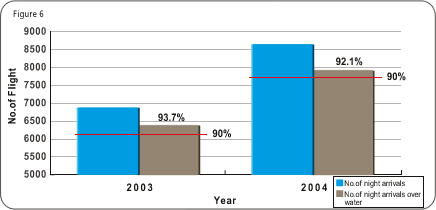
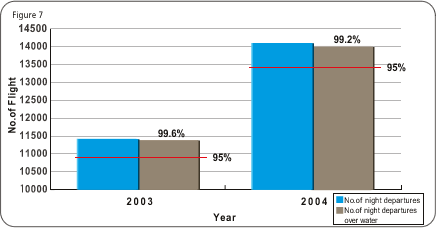
Quieter Arrival
Given favourable weather and flight conditions, from 11:00pm to 7:00am, aircraft approaching from the northeast could adopt the Continuous Descent Approach (CDA) procedure. The aircraft would fly higher and in a lower power and drag configuration during the commencement of the approach. As a result, those aircraft should be quieter to areas such as Sai Kung, Tseung Kwan O and Ma On Shan.
Targets for 2004 and 2005
In 2004, 75% of aircraft on approach to the Hong Kong International Airport from the northeast from 11:00pm to 7:00am were able to adopt such procedure. In 2005, we would continue to facilitate airlines to conduct CDA procedure.
Quieter Departure
Aircraft departing to the northeast should adopt the noise abatement departure procedures (NADP) prescribed by the International Civil Aviation Organization1 (ICAO) if safe flight operations permit.
Our efforts began in August 1999 when we first implemented ICAO's older version of NADP. In 2001, the ICAO revised those NADP such that aircraft could commence engine power reduction as low as 800 ft during the initial phase of take off, which was lower than the start point in the former procedures. In March 2002, we implemented these new procedures by which aircraft departing to the northeast should be quieter.
Target for 2005
Airlines are to continue to adopt the NADP for departures to the northeast of the airport.
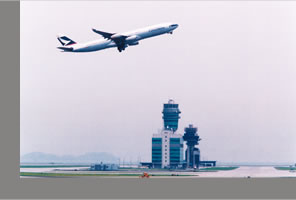
Ban Noisy Aircraft from Operating in Hong Kong
To comply with an ICAO requirement, we have banned noisy "Chapter 2" aircraft2 from using the Hong Kong International Airport since 1 July 2002. At present, only newer and quieter "Chapter 3" aircraft3 are allowed to use our airport. The banning of "Chapter 2" aircraft should reduce the overall noise in the vicinity of flight paths.
Target for 2005
We will keep on prohibiting "Chapter 2" aircraft from using the Hong Kong International Airport.
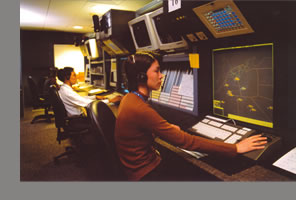
Note:
|
| 1 |
ICAO is an United Nation organization established under the Chicago Convention on International Civil Aviation in November of 1944 for developing the principles and techniques of international air navigation and for fostering the planning and development of international air transport. As at the end of 2004, there were 188 Contracting States to the convention.
|
| 2 |
"Chapter 2" aircraft refer to those aircraft which only meet the standards of noise specified in Volume I, Part II, Chapter 2 of Annex 16 to the Convention on International Civil Aviation.
|
| 3 |
"Chapter 3" aircraft refer to those aircraft which meet the standards of noise specified in Volume I, Part II, Chapter 3 of Annex 16 to the Convention on International Civil Aviation. |
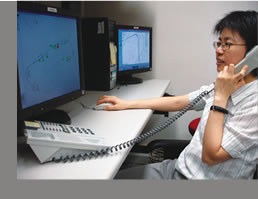 Information to the Public Information to the Public
Maintain Complaint Hotline
In 2004, we have handled 353 aircraft noise complaints (Figure 8), which is 14% more than the 310 complaints in 2003 and 8.6% more than the 325 complaints in 2002. Lower complaint figure in 2003 was probably due to the low air traffic as a result of the outbreak of SARS (Severe Acute Respiratory Syndrome). Comparison with the 2002 complaint figure is more meaningful since 2002 was a normal year. The comparison also shows a positive relationship between numbers of complaints and air traffic volumes.
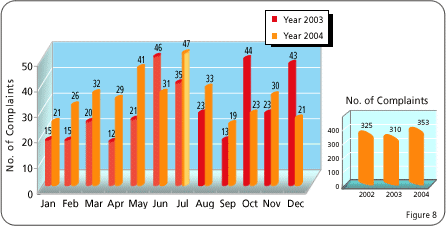
Information to Legislative Council, District Council and Local Residents
During 2004, we held or attended a total of six meetings with several members of the Legislative Council, the Kwai Tsing District Council and the Central & Western District Council about aircraft noise issues. During the meeting, we explained the noise impacts and the mitigating measures we had implemented. In addition, we have arranged two briefings to Tung Chung residents and arranged a visit for the Tsuen Wan & Kwai Tsing District Councils to our air traffic control complex.
Publish Noise Data in CAD Website
To facilitate the public to access aircraft noise information, we regularly upload noise data on our website.
Targets for 2004 and 2005
In 2005, we would continue to carry those 2004 targets onboard to provide the community with noise information.
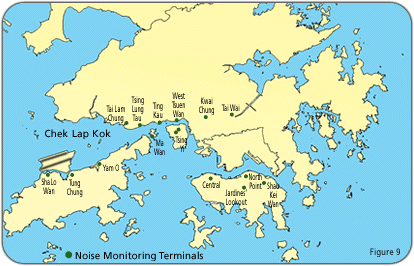
Noise Monitoring
CAD has been monitoring noise in the vicinity of the flight paths with the aid of a computer based aircraft noise and flight track monitoring system (ANFTMS). At present, we have installed 16 fixed noise monitors (Figure 9) to collect noise data in real time.
Our ANFTMS would correlate radar information on flight tracks with noise data from noise monitors. That has allowed us to compile statistics on aircraft noise and investigate into aircraft noise complaints.
Apart from monitoring the noise of jet aircraft, CAD has also been monitoring the helicopter noise impact in the vicinity of the Shun Tak Heliport and the West Kowloon Heliport by using portable noise monitors.
Targets for 2004 and 2005
In 2004, we relocated the noise monitor at Ma Wan Service Reservoir to the nearby residential estate to improve the representativeness of the noise data. We will keep on reviewing the need for installing new noise monitors or relocating existing ones in 2005 to further enhance our noise monitoring capability. In addition, we planned to procure additional monitor equipment as spare to reduce the maintenance time for noise monitors.
|